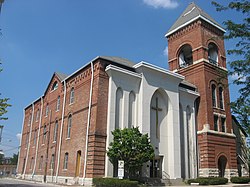
The Mother Bethel African Methodist Episcopal Church is an historic church and congregation which is located at 419 South 6th Street in Center City Philadelphia, Pennsylvania, USA. The congregation, founded in 1794, is the oldest African Methodist Episcopal congregation in the nation.
Bethel African Methodist Episcopal Church, Bethel AME Church, Greater Bethel AME Church or Union Bethel AME Church may refer to:

The history of Indianapolis spans three centuries. Founded in 1820, the area where the city now stands was originally home to the Lenape. In 1821, a small settlement on the west fork of the White River at the mouth of Fall Creek became the county seat of Marion County, and the state capital of Indiana, effective January 1, 1825. Initially the availability of federal lands for purchase in central Indiana made it attractive to the new settlement; the first European Americans to permanently settle in the area arrived around 1819 or early 1820. In its early years, most of the new arrivals to Indianapolis were Europeans and Americans with European ancestry, but later the city attracted other ethnic groups. The city's growth was encouraged by its geographic location, 2 miles (3.2 km) northwest of the state's geographic center. In addition to its designation as a seat of government, Indianapolis's flat, fertile soil, and central location within Indiana and the Midwest, helped it become an early agricultural center. Its proximity to the White River, which provided power for the town's early mills in the 1820s and 1830s, and the arrival of the railroads, beginning in 1847, established Indianapolis as a manufacturing hub and a transportation center for freight and passenger service. An expanding network of roads, beginning with the early National Road and the Michigan Road, among other routes, connected Indianapolis to other major cities.

Christ Church Cathedral is the cathedral for the Episcopal Diocese of Indianapolis. Christ Church parish was formally organized in 1837. The present-day church building was erected in 1857 on Monument Circle at the center of downtown Indianapolis to replace the parish's first church built on the same site. Designed by architect William Tinsley, the English Gothic Revival-style structure is the oldest church building in Indianapolis and Marion County, Indiana, that has remained in continuous use. It is also the oldest building on Monument Circle. Christ Church is known for its music, especially its pipe organs, one of which was donated by Ruth Lilly, and its professional Choir of Men and Boys and Girls' Choir. The parish is also known for its community service, including an annual strawberry festival fundraiser and other charitable work. Christ Church Cathedral was added to the National Register of Historic Places on July 10, 1973. It is located in the Washington Street-Monument Circle Historic District.

The Bethel African Methodist Episcopal Church and Parsonage is an historic church and parsonage at 6 Sever Street in Plymouth, Massachusetts. The congregation, founded in 1866, is one of a small number of African Methodist Episcopal (AME) congregations in eastern Massachusetts, and is an enduring component of the small African-American community in Plymouth. Its church, built about 1840 as a commercial building and consecrated in 1870, was listed on the National Register of Historic Places in 2007.

St. Mary Catholic Church is a parish of the Roman Catholic Church in Indianapolis, Indiana, in the Archdiocese of Indianapolis.

The Metropolitan African Methodist Episcopal Zion Church is a historic Methodist Episcopal Church at 2051 Main Street in Hartford, Connecticut. This High Victorian Gothic structure was built in 1873-74 for an Episcopal congregation, and has since 1926 been the home to the city's oldest African-American congregation, which was established in 1833. The church was listed on the National Register of Historic Places in 1994.

Bethel A.M.E. Church is located in Davenport, Iowa, United States. It was listed on the National Register of Historic Places in 1983.

The British Methodist Episcopal (BME) Church, Salem Chapel was founded in 1820 by African-American freedom seekers in St. Catharines, Ontario. It is located at 92 Geneva St., in the heart of Old St. Catharines. The church is a valued historical site due to its design, and its important associations with abolitionist activity.
The following is a timeline of the history of the city of Indianapolis, Indiana, United States.
Bethel African Methodist Episcopal Church is a church in Morristown, New Jersey, USA.
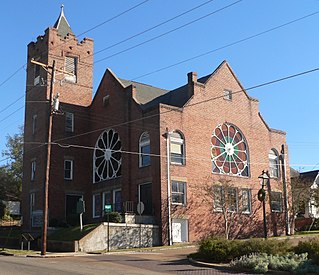
Bethel African Methodist Episcopal Church is a historic African Methodist Episcopal (A.M.E.) church located at 805 Monroe Street in Vicksburg, Mississippi. The church was added to the National Register of Historic Places on July 30, 1992; and is listed as a Mississippi Landmark since November 10, 1992.

The Clinton African Methodist Episcopal Zion Church is a historic church at 9 Elm Court in Great Barrington, Massachusetts. It was the first African American church in Berkshire County, and it was a place where noted Great Barrington native W.E.B. Du Bois is known to have attended services. The Shingle style church was completed in 1887, and continues to serve as a center of African American worship in southern Berkshire County.
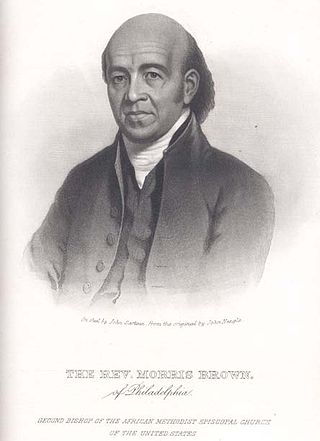
Morris Brown was one of the founders of the African Methodist Episcopal Church, and its second presiding bishop. He founded Emanuel AME Church in his native Charleston, South Carolina. It was implicated in the slave uprising planned by Denmark Vesey, also of this church, and after that was suppressed, Brown was imprisoned for nearly a year. He was never convicted of a crime.

Bethel AME Church of Crawfordsville is a historic African Methodist Episcopal church located at Crawfordsville, Montgomery County, Indiana. It was built in 1892, and is a one-story, gable fronted frame building on a brick foundation. It features a large round-arched window and two-story, square corner tower. Portions of the building are believed to date to 1847. Also on the property is a contributing one-story, Queen Anne style cottage that served as the original parsonage.

Roberts Park Methodist Episcopal Church, whose present-day name is Roberts Park United Methodist Church, was dedicated on August 27, 1876, making it one of the oldest church remaining in downtown Indianapolis. Diedrich A. Bohlen, a German-born architect who immigrated to Indianapolis in the 1850s, designed this early example of Romanesque Revival architecture. The church is considered one of Bohlen's major works. Constructed of Indiana limestone at Delaware and Vermont Streets, it has a rectangular plan and includes a bell tower on the southwest corner. The church is known for its interior woodwork, especially a pair of black-walnut staircases leading to galleries (balconies) surrounding the interior of three sides of its large sanctuary. The church was added to the National Register of Historic Places on August 19, 1982. It is home to one of several Homeless Jesus statues around the world, this one located behind the church on Alabama Street.

Bethel A.M.E. Church is a historic African Methodist Episcopal church located at Richmond, Wayne County, Indiana. The congregation was founded in 1836. The church was built in 1854, and enlarged and remodeled in the Romanesque Revival style with a mix of Neo-classical elements in 1892–1894. It is a one-story, cruciform plan, brick building with a 2+1⁄2-story bell tower. The church serves as an educational, political, and cultural center for the local African American community.
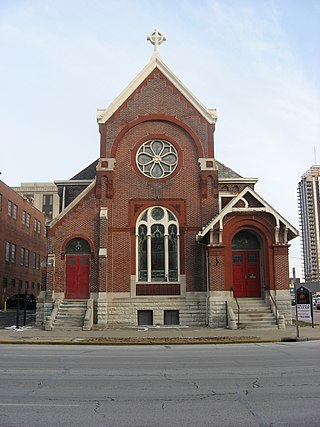
Mount Pisgah Lutheran Church, also known in its early years as the First Lutheran Church and First English Lutheran Church and more recently as The Sanctuary on Penn, is located at 701 North Pennsylvania Street in downtown Indianapolis, Indiana. The historic church was built by the city's first Lutheran congregation, which organized in 1837, and was its third house of worship. The former church, whose present-day name is The Sanctuary on Penn, is operated as a for-profit event venue.
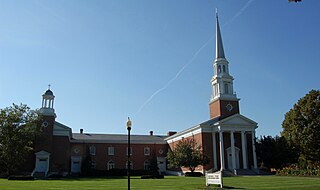
Meridian Street United Methodist Church, known in its early years as Wesley Chapel, the Meridian Street Methodist Episcopal Church, and the Meridian Street Methodist Church, is a Methodist church located at 5500 North Meridian Street in Indianapolis, Indiana. The church originated from the first Methodist congregation in Indianapolis that began in a log cabin in 1821–22 with fifty members. The congregation worshipped at several locations and erected four earlier churches on Monument Circle and along Meridian Street in downtown Indianapolis before it merged with the Fifty-first Street Methodists in 1945. The first service at its North Meridian Street location was held on June 29, 1952. Designed by the architectural firm of Russ and Harrison, the Georgian-Colonial-style, red-brick church is noted for its architecture, pipe organ, and formal parlor. The Aldersgate addition on the west side (rear) of the church was consecrated on October 4, 1989.

The Little Bethel African Methodist Episcopal Church, now the Bethel African Methodist Episcopal Church, is a historic church building and congregation at 44 Lake Avenue in Greenwich, Connecticut, United States. Founded in 1882, the congregation was Greenwich's first African-American congregation of any denomination, and remains a center of African-American society in the town. Its current church, built in 1921 on the site of its first church, is a good example of Late Gothic Revival architecture, and was listed on the National Register of Historic Places in 2010.
